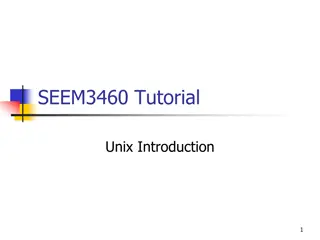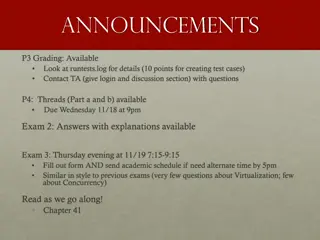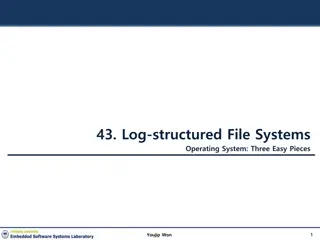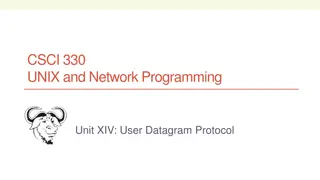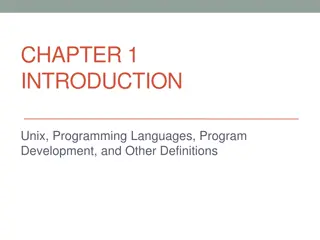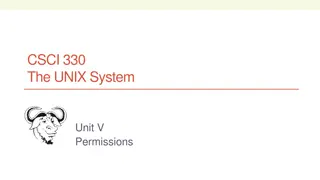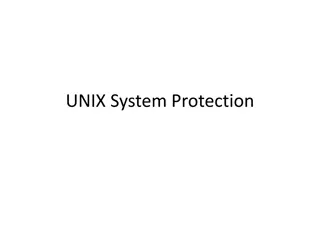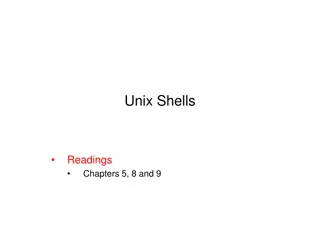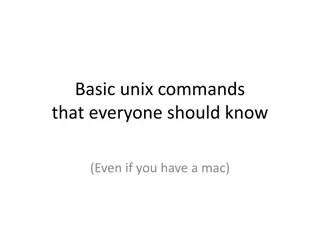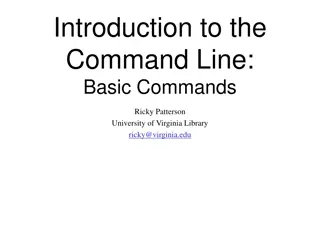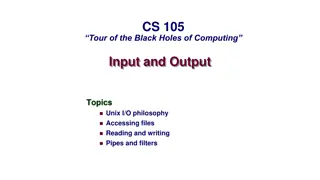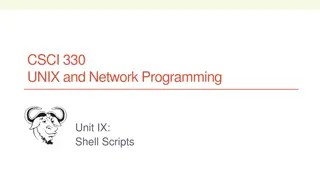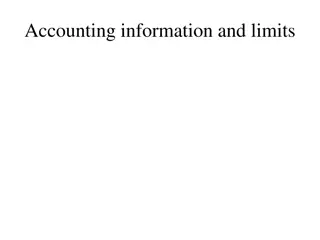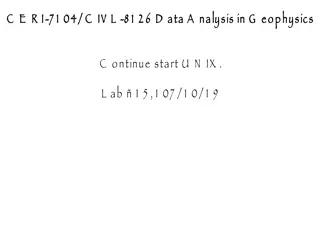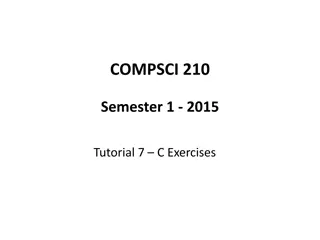Understanding Filesystems and Inodes in UNIX
Delve into the complexities of filesystems such as FFS and LFS, exploring concepts like i-nodes, ownership, permissions, and indirect blocks. Learn about the structure of UNIX inodes, path searching, caching, read-ahead optimization, and the limitations of the original UNIX filesystem. Unravel the intricacies of storage management and data access in UNIX environments.
Download Presentation

Please find below an Image/Link to download the presentation.
The content on the website is provided AS IS for your information and personal use only. It may not be sold, licensed, or shared on other websites without obtaining consent from the author. Download presentation by click this link. If you encounter any issues during the download, it is possible that the publisher has removed the file from their server.
E N D
Presentation Transcript
Filesystems (II) FFS, LFS
Zooming in on i-node i-node: structure for per-file metadata (unique per file) contains: ownership, permissions, timestamps, about 10 data-block pointers i-nodes form an array, indexed by i-number so each i-node has a unique i-number Array is explicit for FFS, implicit for LFS (its i-node map is cache of i-nodes indexed by i-number) Indirect blocks: i-node only holds a small number of data block pointers (direct pointers) For larger files, i-node points to an indirect block containing 1024 4-byte entries in a 4K block Each indirect block entry points to a data block Can have multiple levels of indirect blocks for even larger files
Unix Inodes and Path Search Unix Inodes are not directories Inodes describe where on disk the blocks for a file are placed Directories are files, so inodes also describe where the blocks for directories are placed on the disk Directory entries map file names to inodes To open /one , use Master Block to find inode for / on disk Open / , look for entry for one This entry gives the disk block number for the inode for one Read the inode for one into memory The inode says where first data block is on disk Read that block into memory to access the data in the file This is why we have open in addition to read and write Every file/directory operation typically involves many I/O operations! 3
Caching and read ahead Unix file system implemented two additional optimizations Caching: keep a buffer cache in memory Locality = avoid cost of expensive I/O Even a relatively small cache makes a difference Read ahead: read the whole file (into cache) when it is opened Many files accessed sequentially Limited by cache size 4
Whats wrong with original unix FS? Original UNIX FS was simple and elegant, but slow Could only achieve about 20 KB/sec/arm; ~2% of 1982 disk bandwidth Problems: Blocks too small 512 bytes (matched sector size) Consecutive blocks of files not close together Yields random placement for mature file systems i-nodes far from data All i-nodes at the beginning of the disk, all data after that i-nodes of directory not close together no read-ahead Useful when sequentially reading large sections of a file
FFS Changes -- Locality is important Aspects of new file system: 4096 or 8192 byte block size (why not larger?) large blocks and small fragments disk divided into cylinder groups each contains superblock, i-nodes, bitmap of free blocks, usage summary info Note that i-nodes are now spread across the disk: Keep i-node near file, i-nodes of a directory together (shared fate) Cylinder groups ~ 16 cylinders, or 7.5 MB Cylinder headers spread around so not all on one platter
FFS Locality Techniques Goals Keep directory within a cylinder group, spread out different directories Allocate runs of blocks within a cylinder group, every once in a while switch to a new cylinder group (jump at 1MB) Layout policy: global and local Global policy allocates files & directories to cylinder groups picks optimal next block for block allocation Local allocation routines handle specific block requests select from a sequence of alternative if need to
FFS Results 20-40% of disk bandwidth for large reads/writes 10-20x original UNIX speeds Size: 3800 lines of code vs. 2700 in old system 10% of total disk space unusable (except at 50% performance price) Could have done more; later versions do Watershed moment for OS designers File system matters
FFS Summary 3 key features: Parameterize FS implementation for the hardware it s running on Measurement-driven design decisions Locality wins Major flaws: Measurements derived from a single installation Ignored technology trends A lesson for the future: don t ignore underlying hardware characteristics Contrasting research approaches: improve what you ve got vs. design something new
File operations still expensive How many operations (seeks) to create a new file? New file, needs a new inode But at least a block of data too Check and update the inode and data bitmap (eventually have to be written to disk) Not done yet need to add it to the directory (update the directory inode and the directory data block may need to split if its full) Whew!! How does all of this even work? So what is the advantage? Not removing any operations Seeks are just shorter
Crash consistency/Journaling Problem: Recall: file ops can cause multiple disk ops Example, add a block to a file With cache, and block reordering what happens on a crash? Any subset of the ops may have been committed to disk Disk state is inconsistent File checkers where a critical part of the OS Solution: Journaling Log intended ops in a journal commit them Once committed, start disk ops Once committed, mark log as done How does this solve the problem? 12
Log-Structured/Journaling File System Radically different file system design Technology motivations: CPUs outpacing disks: I/O becoming more-and-more of a bottleneck Large RAM: file caches work well, making most disk traffic writes Problems with (then) current file systems: Lots of little writes Synchronous: wait for disk in too many places makes it hard to win much from RAIDs, too little concurrency 5 seeks to create a new file: (rough order) 1. file i-node (create) 2. file data 3. directory entry 4. file i-node (finalize) 5. directory i-node (modification time) 6. (not to mention bitmap updates)
LFS Basic Idea Log all data and metadata with efficient, large, sequential writes Do not update blocks in place just write new versions in the log Treat the log as the truth, but keep an index on its contents Not necessarily good for reads, but trends help Rely on a large memory to provide fast access through caching Data layout on disk has temporal locality (good for writing), rather than logical locality (good for reading) Why is this a better? Because caching helps reads but not writes!
Basic idea We buffer all updates, and write them together in one big sequential write Good for the disk Example above, writes to two different files were written together (along with the new version of i-node) in one write How much should we buffer? What happens if too much? If too little? But how do we find a file?? All problems in CS solved with another level of indirection
Devil is in the details Two potential problems: Log retrieval on cache misses how do we find the data? Wrap-around: what happens when end of disk is reached? No longer any big, empty runs available How to prevent fragmentation?
LFS vs. UFS inode file2 file1 directory data dir1 dir2 Unix File System inode map dir2 dir1 Blocks written to create two 1-block files: dir1/file1 and dir2/file2, in UFS and LFS Log Log-Structured File System file1 file2 17
i-node map A map keeping track of the location of i-nodes Anytime an i-node is written to disk, the imap is updated But is that any better? In a second Most of the time the imap is in memory, so access is fast Updated imap is saved as part of the log! but how do we find it!
Final piece to the solution Checkpoint region is written to point to the location of the imap Also serves as an indicator of a stable point in the file system for crash recovery So, to read a file from LFS: Read the CR, use it to read and cache the imap After that, it is identical to FFS Are reads fast?
What about directories? When a file is updated, its inode changes (new copy) We need to update the directory inode (also creating a copy) We need to update its parent directory Ugh .what to do? Inode map helps with that too just keep track of inode number and resolve it through inode map
LFS Disk Wrap-Around/Garbage collection Compact live info to open up large runs of free space Problem: long-lived information gets copied over-and-over Thread log through free spaces Problem: disk fragments, causing I/O to become inefficient again Solution: segmented log Divide disk into large, fixed-size segments Do compaction within a segment; thread between segments When writing, use only clean segments (i.e. no live data) Occasionally clean segments: read in several, write out live data in compacted form, leaving some fragments free Try to collect long-lived info into segments that never need to be cleaned Note there is not free list or bit map (as in FFS), only a list of clean segments
LFS Segment Cleaning Which segments to clean? Keep estimate of free space in each segment to help find segments with lowest utilization Always start by looking for segment with utilization=0, since those are trivial to clean If utilization of segments being cleaned is U: write cost = (total bytes read & written)/(new data written) = 2/(1-U) U is 0) write cost increases as U increases: U = .9 => cost = 20! Need a cost of less than 4 to 10; => U of less than .75 to .45 (unless How to clean a segment? Segment summary block contains map of the segment Must list every i-node and file block For file blocks you need {i-number, block #} Through i-map you check if this block is still being used for the (i- number, block #)
Is this a good paper? What were the authors goals? What about the evaluation/metrics? Did they convince you that this was a good system/approach? Does the system/approach meet the Test of Time challenge? How would you review this paper today?


